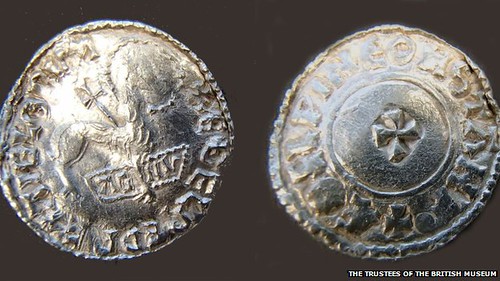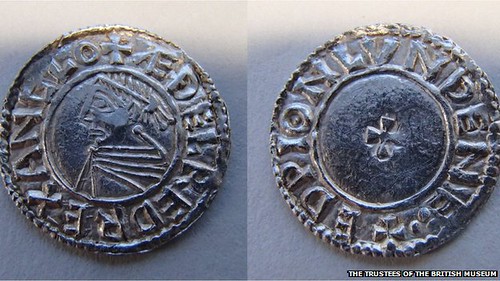
PREV ARTICLE
NEXT ARTICLE
FULL ISSUE
PREV FULL ISSUE
LARGE HOARD OF ANGLO SAXON COINS DISCOVERED
Arthur Shippee, Anne E. Bentley and David Pickup forwarded this BBC News article about a large hoard of Anglo Saxon coins discovered recently. Thanks.
-Editor
More than 5,000 coins were found wrapped in a lead sheet and buried in Lenborough, near Padbury. They depict the heads of kings Ethelred the Unready and Canute and come from 40 different mints around England. A final valuation has yet to be completed, but it is thought the coins could be worth up to £1.3m. Chairman of Buckinghamshire County Museum Trustees Bob Sutcliffe said they were waiting for a figure "before we decide if we are going to try and acquire this hoard". The 5,251 coins were found by Weekend Wanderers Detecting Club member Paul Coleman, from Southampton, on 21 December. The find is thought to be one of the biggest in the UK, while the British Museum said it was "the largest Anglo Saxon coin hoard found since the Treasure Act began" in 1996. The lead wrapping provided protection against the elements, meaning the coins were very well preserved. They went on display at the British Museum on 10 February.
Well preserved, indeed! Look at these babies...
-Editor


To read the complete article, see:
David Sundman forwarded this story from The Times. Thanks.
-Editor
Mr Coleman, 59, lost the good-natured tussle with his friend and changed his path to one that led him to discover 5,200 silver coins worth an estimated £1.04 million. Speaking as the coins were put on display yesterday for the first time at the British Museum, Mr Coleman said that his group decided that the field, near Lenborough in Buckinghamsire, was a dud. “The gate was at the top end of the field, but rather than just pick up our equipment we decided to use it on the way,” he said. The pair’s metal detectors interfered with each other, so Mr Coleman asked his friend, whom he named as Jack, to move out of the way. “He said, ‘No, you move over’ and I walked onto it. He said he would never ask me to move over again. He’d move over himself.” Mr Coleman, who made the discovery on December 21, dug two feet into the soil to find a lead container shaped like a Cornish pasty, folded over and crimped along one side. He will be entitled to half of the value of the hoard, which will be determined after a coroner confirms that it fits the definition of treasure under the Treasure Act. The remainder will go to the landowner, who does not wish to be named.
To read the complete article (subscription required), see:
The Numismatic Bibliomania Society is a non-profit organization promoting numismatic literature. See our web site at coinbooks.org. To submit items for publication in The E-Sylum, write to the Editor at this address: whomren@gmail.com To subscribe go to: https://my.binhost.com/lists/listinfo/esylum All Rights Reserved. NBS Home Page Contact the NBS webmaster 
|

